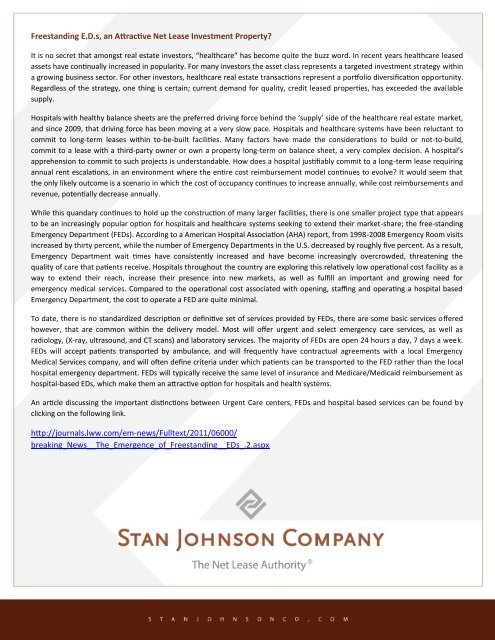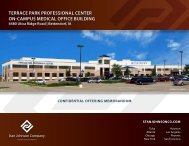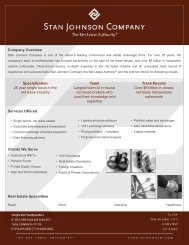FSED - Stan Johnson Company
FSED - Stan Johnson Company
FSED - Stan Johnson Company
You also want an ePaper? Increase the reach of your titles
YUMPU automatically turns print PDFs into web optimized ePapers that Google loves.
Freestanding E.D.s, an Attractive Net Lease Investment Property?<br />
It is no secret that amongst real estate investors, “healthcare” has become quite the buzz word. In recent years healthcare leased<br />
assets have continually increased in popularity. For many investors the asset class represents a targeted investment strategy within<br />
a growing business sector. For other investors, healthcare real estate transactions represent a portfolio diversification opportunity.<br />
Regardless of the strategy, one thing is certain; current demand for quality, credit leased properties, has exceeded the available<br />
supply.<br />
Hospitals with healthy balance sheets are the preferred driving force behind the ‘supply’ side of the healthcare real estate market,<br />
and since 2009, that driving force has been moving at a very slow pace. Hospitals and healthcare systems have been reluctant to<br />
commit to long-term leases within to-be-built facilities. Many factors have made the considerations to build or not-to-build,<br />
commit to a lease with a third-party owner or own a property long-term on balance sheet, a very complex decision. A hospital’s<br />
apprehension to commit to such projects is understandable. How does a hospital justifiably commit to a long-term lease requiring<br />
annual rent escalations, in an environment where the entire cost reimbursement model continues to evolve? It would seem that<br />
the only likely outcome is a scenario in which the cost of occupancy continues to increase annually, while cost reimbursements and<br />
revenue, potentially decrease annually.<br />
While this quandary continues to hold up the construction of many larger facilities, there is one smaller project type that appears<br />
to be an increasingly popular option for hospitals and healthcare systems seeking to extend their market-share; the free-standing<br />
Emergency Department (FEDs). According to a American Hospital Association (AHA) report, from 1998-2008 Emergency Room visits<br />
increased by thirty percent, while the number of Emergency Departments in the U.S. decreased by roughly five percent. As a result,<br />
Emergency Department wait times have consistently increased and have become increasingly overcrowded, threatening the<br />
quality of care that patients receive. Hospitals throughout the country are exploring this relatively low operational cost facility as a<br />
way to extend their reach, increase their presence into new markets, as well as fulfill an important and growing need for<br />
emergency medical services. Compared to the operational cost associated with opening, staffing and operating a hospital based<br />
Emergency Department, the cost to operate a FED are quite minimal.<br />
To date, there is no standardized description or definitive set of services provided by FEDs, there are some basic services offered<br />
however, that are common within the delivery model. Most will offer urgent and select emergency care services, as well as<br />
radiology, (X-ray, ultrasound, and CT scans) and laboratory services. The majority of FEDs are open 24 hours a day, 7 days a week.<br />
FEDs will accept patients transported by ambulance, and will frequently have contractual agreements with a local Emergency<br />
Medical Services company, and will often define criteria under which patients can be transported to the FED rather than the local<br />
hospital emergency department. FEDs will typically receive the same level of insurance and Medicare/Medicaid reimbursement as<br />
hospital-based EDs, which make them an attractive option for hospitals and health systems.<br />
An article discussing the important distinctions between Urgent Care centers, FEDs and hospital based services can be found by<br />
clicking on the following link.<br />
http://journals.lww.com/em-news/Fulltext/2011/06000/<br />
breaking_News__The_Emergence_of_Freestanding__EDs_.2.aspx
The Investor Market<br />
As more FEDs are built in the years ahead, investors will have the opportunity to purchase these facilities as net leased investment<br />
opportunities. Hospitals will likely look to third-party developers to construct these, off-campus, and non-core facilities as they will<br />
seek to keep their available capital invested in the operations, or available for physician practice and competitor acquisition<br />
opportunities.<br />
The typical FED will be between 10,000 to 15,000 square feet, with a cost to construct averaging between $350 - $450 per square<br />
foot, depending on the market and land cost. The high price per square foot to construct will pose as the biggest challenge for net<br />
lease investors analyzing this type of investment. It is important to note that the most successful FEDs are located on high-traffic<br />
retail out parcels therefore; proposed FEDs should not sacrifice business opportunities in favor of cheaper land costs. In<br />
comparison to a Walgreens drug store, (a popular net leased investment) the cost to build is considerably higher, can have far less<br />
favorable credit supporting the lease and is extremely ‘special purpose’ in its construction and design. With average NNN rents for<br />
FEDs starting at $38+ per square foot, investors will have legitimate concerns with regard to their ability to replace the rental<br />
income stream, should the tenant default. A net lease investor will look for longer lease terms (15 to 20 years), annual rent<br />
escalations and more favorable cash-on-cash yields as protection against these negative elements.<br />
In comparing the FED to a typical retail net lease investment the FED does offer some attractive advantages. FEDs typically achieve<br />
breakeven performance with annual volume of 13,000 to 15,000 patient visits. For a facility open 24/7, 365 days per year this<br />
translates into a modest average of only 38 patients per day. It is anticipated that FED EBITDA/rent coverage ratios could easily<br />
exceed 4 times rent which, when compared to the average retailer’s rent coverage ratio of 1.25, this should increase the appeal of<br />
the asset for the net lease investor. An additional highlight to this investment type has been the access to attractive debt. Lenders<br />
are very interested in the relative safety offered by investments in healthcare real estate, and the competition for the product<br />
amongst lenders is providing favorable debt terms in the market.<br />
Key Points<br />
<br />
<br />
<br />
<br />
<br />
<br />
Developers and FED tenants should look for sites near well-known retail outlets, as this will increase customer traffic as well as<br />
brand awareness within a new market.<br />
Proximity to a popular retail center will make the real estate investment more attractive to net lease investors.<br />
Proposed development projects sponsored by hospitals or healthcare systems will be viewed far more favorably in the<br />
investment market than projects sponsored by independent operators or operator/hospital joint ventures.<br />
Require long-term lease commitments of 15 to 20 years. (A project this expensive requires a demonstration of commitment on<br />
the part of the tenant)<br />
Look for opportunities in rural communities where emergency options are limited to older, functionally obsolescent facilities.<br />
Credit behind the lease will be heavily scrutinized and when present, reflected in the pricing paid for the investment.<br />
Conclusion<br />
Freestanding Emergency Departments represent an evolution in the way healthcare services are delivered, and provide<br />
tremendous benefits to healthcare providers and consumers alike, by offering much needed services in a more cost efficient<br />
environment. As more and more investors recognize the impressive growth and demographics driving the healthcare industry,<br />
competition to own healthcare real estate will continue to increase. FEDs should be very attractive to net lease investors, if the<br />
leases are structured appropriately.<br />
Toby Scrivner, Director<br />
<strong>Stan</strong> <strong>Johnson</strong> <strong>Company</strong>




